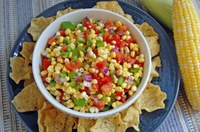Prairie Fare: Nourish and Protect Your Skin This Winter
(Click an image below to view a high-resolution image that can be downloaded)
By Julie Garden-Robinson, Food and Nutrition Specialist
NDSU Extension
I noticed my husband sliding his back on the doorframe near our living room. I knew the reason.
“Where’s the back scratcher?” he asked.
I retrieved it and handed it to him. Evidently, the doorframe wasn’t doing the trick.
Yes, it’s winter, I thought to myself.
As I watched him scratch his back, I became aware of the itchiness of my skin.
I reached down to scratch my lower legs. Driving around with hot air blowing on my legs from our vehicle’s heater wasn’t doing my skin a favor.
However, heat is a necessity in the winter.
The palms of my hands were rough like fine-grade sandpaper. I had ventured outside without mittens the other day, and my skin did not approve.
I got up out of my easy chair to get some lotion for my hands and legs. Actually, my back was feeling itchy, too.
We all need to take care of our skin all year long, but especially in the winter. Skin is the largest organ in the body. It serves as a protective barrier to help prevent harmful substances from entering the body. Sun and the dry air of winter can be damaging to our skin.
For example, wearing sunscreen throughout all seasons of the year helps protect our skin from the sun’s damaging rays. Applying moisturizer helps keep our skin hydrated to serve as an effective protective barrier. Staying hydrated can help prevent wrinkles and lines from becoming noticeable, too.
Two of the most important barriers protecting the skin are sebum, a substance secreted by sebaceous glands to reduce water loss and prevent infection, and pH (alkalinity or acidity). The low pH of the skin’s surface helps protect against disease-causing bacteria.
Most of us maintain a supply of moisturizers especially during the cold, dry winter months. We also can nourish our skin from the inside by enjoying a variety of foods:
- Include about 4 to 5 cups of colorful antioxidant-rich fruits and vegetables in your daily diet. All forms of fruits and vegetables, including canned, fresh and frozen, count toward the daily goal.
- Get your omega-3 fatty acids from fatty fish, such as albacore tuna, halibut, mackerel and sardines, and nuts and seeds, such as walnuts and pumpkin seeds.
- Make half your grain choices whole grains for a variety of vitamins. Grains provide a variety of vitamins.
- Enjoy lean meat, poultry, fish, low-fat dairy, beans and other protein-rich foods to provide your body with a variety of nutrients for building and repairing tissues.
Stay hydrated during the winter months and all year. Monitor your hydration by checking the color of your urine. It should be light yellow, about the color of straw.
On average, women need 9 cups of liquid from beverages and food, and men need 13 cups daily. Fruits and vegetables are very high in water. Keep a pitcher of cold water in your refrigerator to promote water consumption, and drink warm beverages such as herbal tea.
We have many other ways to take care of our skin during dry, cold months, according to these tips that I adapted from the American Academy of Dermatology:
- Shorten your baths or showers to five to 10 minutes. Use warm water instead of hot water, which is more drying. Use a limited amount of a gentle fragrance-free cleanser, and blot skin gently dry.
- Choose gentle skin care products. Deodorant soaps and/or products with alcohol and fragrances tend to be harsh on your skin.
- Apply a moisturizer right after washing your hands or face or drying off after taking a shower. Ointments, creams and other moisturizers work by trapping moisture in your skin.
- Read the ingredients on the moisturizer. Shea butter, glycerin, lanolin, mineral oil and petrolatum are among the ingredients that are most effective in trapping moisture.
- Don’t forget to wear lip balm to help prevent your lips from cracking.
- Don’t forget your mittens. Protect your skin when you go outside in cold weather.
- Use a humidifier to add moisture to the air in your home.
- Remember that cozying up to a heater or fireplace can be drying to your skin. Keep a little distance and keep your moisturizers nearby.
See https://www.ag.ndsu.edu/nourishyourbody to learn more about taking care of all of your body systems, from bones to skin. Click on the “skin” link to learn more. We invite you to sign up for the free monthly e-newsletter.
Here’s a nutrient-rich, colorful salsa that will have your holiday guests requesting the recipe. It’s also fairly low in calories and will help balance the treats of the holidays.
Festive Corn Salsa
4 ears fresh corn, kernels removed (or 2 c. frozen corn, thawed)
1 c. green bell pepper, chopped
1/2 c. red onion, chopped
2 tomatoes, chopped
2 garlic cloves, chopped
2 Tbsp. lemon juice (fresh squeezed) or vinegar
1/2 tsp. black pepper
1/4 tsp. salt
Prepare ingredients as directed. Combine all ingredients in a large bowl. Refrigerate for at least one hour before serving. Serve with chips or crackers.
Makes 10 (1/2-cup) servings. Each serving has 60 calories, 0 grams (g) fat, 2 g protein, 14 g carbohydrate, 2 g fiber and 60 milligrams sodium.
(Julie Garden-Robinson, Ph.D., R.D., L.R.D., is a North Dakota State University Extension food and nutrition specialist and professor in the Department of Health, Nutrition and Exercise Sciences. Follow her on Twitter @jgardenrobinson)
NDSU Agriculture Communication - Dec. 19, 2019
| Source: | Julie Garden-Robinson, 701-231-7187, julie.garden-robinson@ndsu.edu |
|---|---|
| Editor: | Ellen Crawford, 701-231-5391, ellen.crawford@ndsu.edu |



